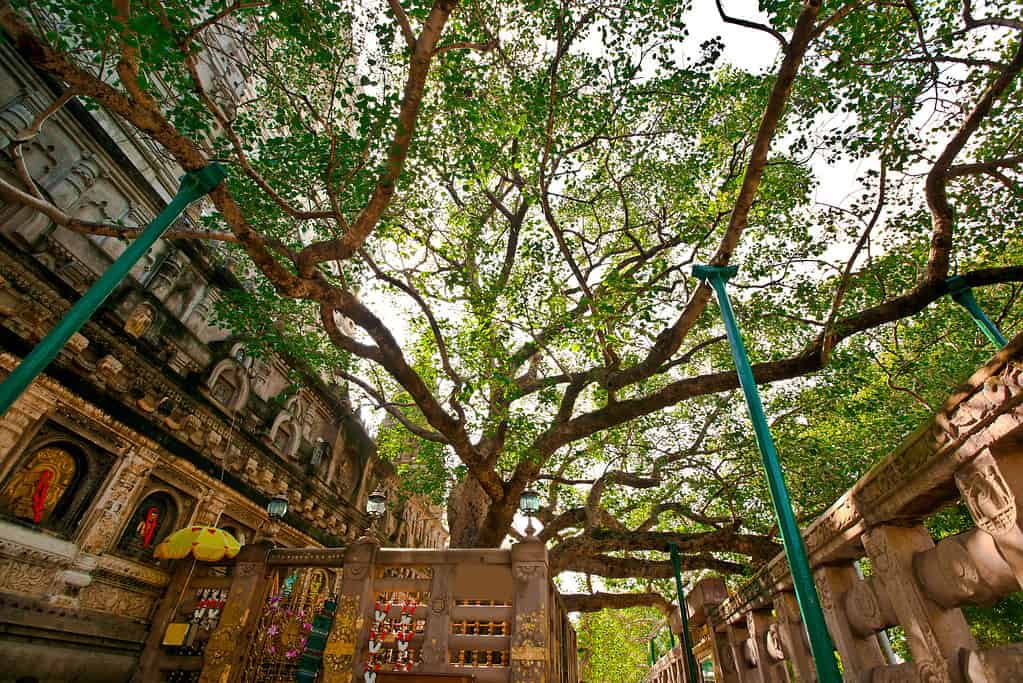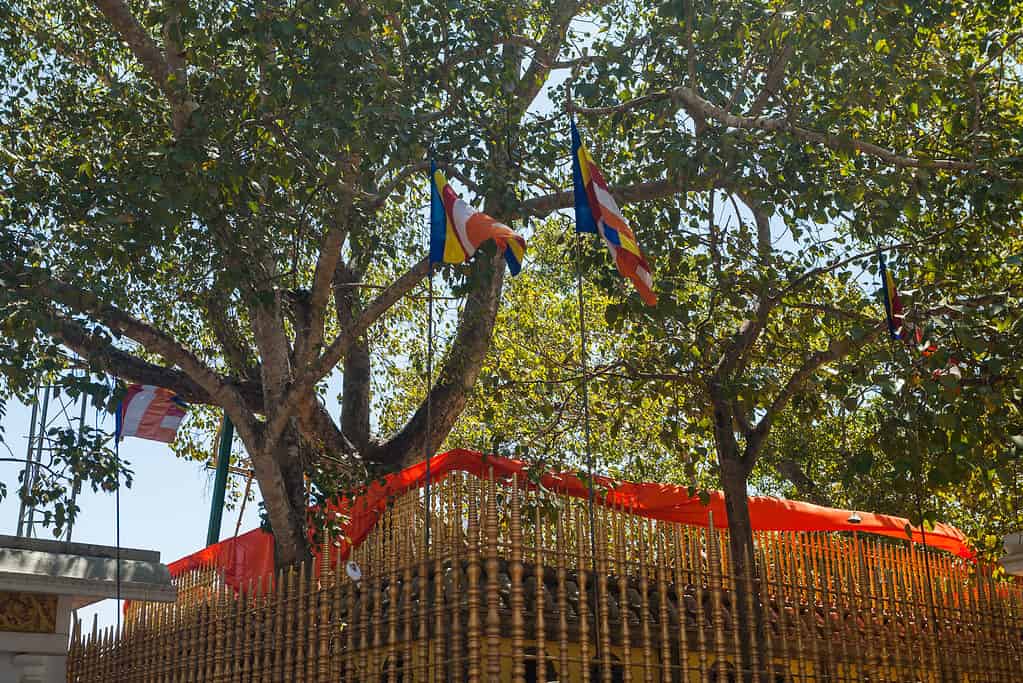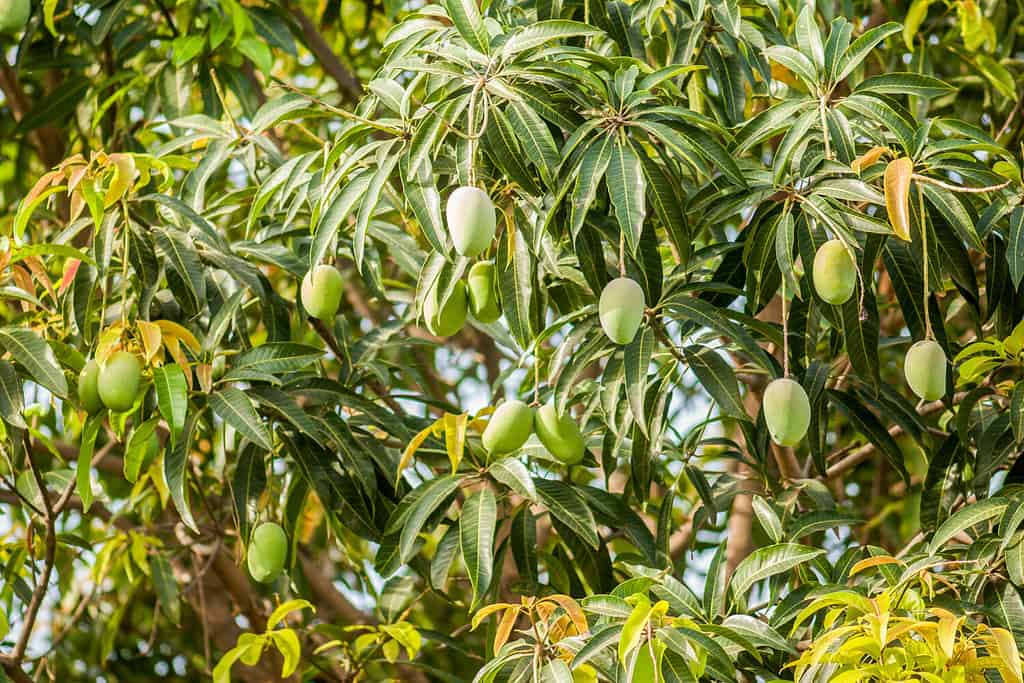The Bodhi Tree is a revered symbol in Buddhism. Today, bodhi trees still exist and hold a deep religious significance to many adherents. Let’s discover the Bodhi Tree and why it’s so important worldwide.
What Is the Bodhi Tree?

The Bodhi Tree, like the one above, was a Sacred Fig Tree where the Buddha achieved nirvana.
©Kridsada Krongmuang/Shutterstock.com
The Bodhi Tree, which means tree of awakening, is a sacred fig tree (Ficus religiosa) with religious significance to people who practice Buddhism. While the central story of Buddhism refers to one specific tree, any sacred fig tree today is considered a bodhi tree.
The word bodhi means enlightenment or awakening, synonymous with nirvana. Nirvana is what all Buddhists strive to maintain.
Reaching nirvana means a person is in a state of being where transcending the idea of self is achieved. A person who has reached nirvana is neither happy, in need of physical or spiritual things, nor do they experience suffering. Nirvana frees a person from dying, rebirth, or any other spiritual recycling that may occur beyond this reality.
Why Is the Bodhi Tree So Important Throughout the World?

The Bodhi Tree is important because the Buddha sat under it until he achieved enlightenment.
©Therd oval/iStock via Getty Images
The Bodhi Tree is important worldwide because the first Buddha achieved enlightenment while sitting under it. Around 500 BCE, Siddhartha Gautama became the Buddha underneath a Sacred Fig Tree. Siddhartha meditated under the original Bodhi Tree for forty-nine days without getting up or taking a break before achieving nirvana.
Today, approximately 500 million people on Earth identify as Buddhists. The largest concentration of believers live on the Indian Subcontinent and in Southeast Asia, though Japan, the United States, and other countries also have sizeable Buddhist populations. As a result, bodhi tree symbolism has a pervasive influence on cultures worldwide.
Is the Original Bodhi Tree Still Alive?
No, the original Bodhi Tree the Buddha sat under when attaining enlightenment is not alive. However, since the existence of the original Bodhi Tree, a Bodhi tree has grown at the original spot of the first Bodhi Tree.
The first Bodhi Tree was destroyed in 254 BCE by the queen of the Indian Subcontinent. Ashoka the Great was her king and ruled a huge area from 268 to 232 BCE, and he was an adherent of Buddhism. After becoming king, he rejected the elaborate traditions associated with Hinduism and influenced many to follow the Buddha.
The queen, named Tissarakkha, was a jealous woman who didn’t like that Ashoka spent time fussing over the bodhi tree. As a result, she had it destroyed. Afterward, her guilt drove her to have the tree replanted in the same spot as the original.
How Many Bodhi Trees Are There Today?
At least 12 different Bodhi trees are connected to the original Bodhi Tree alive today. These trees exist all over the world. Other Bodhi trees are attributed to subsequent Buddhas besides Gautama, including around 30 with direct and verifiable ancient histories.
The Mahabodhi Tree

The Mahabodhi Tree grows on the exact spot of the original Bodhi Tree.
©arthit somsakul/iStock via Getty Images
An ancient Bodhi tree exists in Bihar, India, in the Bodh Gaya, in the exact spot where the original Bodhi Tree stood. This tree is called the Mahabodhi Tree, and it has lived at this location since approximately 250 BCE. While many iterations of this tree have existed since the one that witnessed the Buddha’s enlightenment, the existing tree and its predecessors stand in the same sacred spot where Gautama achieved nirvana.
The Anandabodhi Tree

The Anandabodhi Tree was grown from a sapling of the original Bodhi Tree.
©Casper1774 Studio/Shutterstock.com
Ananda planted a sapling of the original Bodhi Tree at the Jetavana Monastery. Today, it is known as the Anandabodhi Tree. Most adherents believe this tree was grown from a sapling of the original Bodhi Tree and that the Buddha sat under it for a night after its initial planting.
The Jaya Sri Maha Bodhi Tree

The Jaya Sri Maha Bodhi Tree in Sri Lanka is the oldest tree humans have planted.
©Honza Hruby/Shutterstock.com
Sri Lanka is another location that has a sacred bodhi tree named the Jaya Sri Maha Bodhi Tree in Anuradhapura. Like the Anandabodhi Tree, it’s believed that the Jaya Sri Maha Bodhi Tree was grown from a sapling obtained from the original Bodhi Tree. It was planted in its current spot in 288 BCE, and it is the oldest human-planted tree living on Earth.
Offspring of the Mahabodhi, Anandabodhi, and Jaya Sri Maha Bodhi Trees
From these main Bodhi trees created from the original Bodhi Tree, at least 9 saplings have traveled to other parts of the world and become separate trees. As a result, bodhi trees from these saplings exist in Hawaii, a few places in India, Vietnam, California, Japan, the Philippines, Australia, and other places. From these trees, even more have been produced.
What Is the Lifespan of a Sacred Fig Tree (Ficus religiosa)?
Sacred fig trees have a lifespan of around 900 to 1500 years if properly tended. However, the Jaya Sri Maha Bodhi Tree in Sri Lanka is over 2250 years old. It’s believed they may reach ages over 3000 years old.
Bodhi trees, or Sacred Fig Trees, are large semi-deciduous trees that grow up to 100 feet tall. In the contiguous United States, outside of their native habitat that experiences specific monsoon cycles, they behave like evergreens.
Sacred Fig Tree branches fan out into a very wide canopy, and its trunk can grow up to 9 feet around. These trees make great shade trees because their branches fan so far from the trunk. They grow quickly, and in their native ranges in India and Asia, they are commonly used in urban settings.
What Other Tree Species Exist as Bodhi Trees?

Some mango trees are considered bodhi trees.
©Tukaram.Karve/Shutterstock.com
There are more recognized Buddhas than Siddhartha Gautama, and some of these Buddhas sat under trees achieving enlightenment that weren’t sacred fig trees (Ficus religiosa). Some of the other species of bodhi trees include:
- Strangler Fig Trees (Ficus obtusifolia)
- Indian Trumpet Trees (Oroxylum indicum)
- Cobra Saffrons (Mesua ferrea)
- Arjuna Trees (Terminalia arjuna)
- Longleaf Indian Pines (Pinus roxburghii)
- Kadam Trees (Neolamarckia cadamba)
- Giant Thorny Bamboos (Bambusa bambos)
- Sacred Garlic Pears (Crateva religiosa)
- Champaks (Magnolia champaca)
- Indian Pellet Shrubs (Pavetta indica)
- Karnikara Trees (Pterospermum acerifolium)
- Asna Trees (Terminalia elliptica)
- Malacca Trees (Phyllanthus emblica)
- Fragrant Padri Trees (Stereospermum chelonoides)
- Mango Trees (Mangifera indica)
- Sal Trees (Shorea robusta)
- Indian Sirises (Albizia lebbeck)
- Cluster Fig Trees (Ficus racemosa)
- Banyan Fig Trees (Ficus benghalensis)
The photo featured at the top of this post is © Teo Tarras/Shutterstock.com
Thank you for reading! Have some feedback for us? Contact the AZ Animals editorial team.







